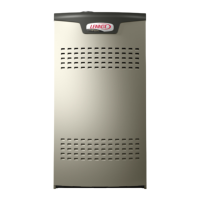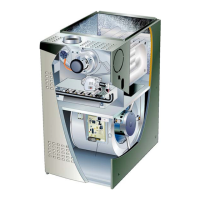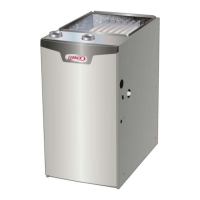Page 26
10 - Is pressure switch closed? Obstructed ue will
cause unit to shut o at pressure switch. Check ue
and outlet for blockages.
11 - Are ame rollout switches tripped? If ame rollout
switches are tripped, call the service technician for
inspection.
Heating Sequence Of Operation (follow steps below)
1 - When thermostat calls for heat, combustion air
blower starts.
2 - Combustion air pressure switch proves blower
operation. Switch is factory-set and requires no
adjustment.
3 - After a 15-second prepurge, the hot surface ignitor
energizes.
4 - After a 20-second ignitor warm-up period, the gas
valve solenoid opens. A 4-second trial for ignition
period begins.
5 - Gas is ignited, ame sensor proves the ame, and
the combustion process continues.
6 - If ame is not detected after rst ignition trial, the
ignition control will repeat steps 3 and 4 four
more times before locking out the gas valve
(“WATCHGUARD” ame failure mode). The ignition
control will then automatically repeat steps 1 through
6 after 60 minutes.
7 - To interrupt the 60-minute “WATCHGUARD” period,
move thermostat from “Heat” to “OFF” then back to
“Heat.” Heating sequence then restarts at step 1.
Gas Pressure Adjustment
Gas Flow (Approximate)
TABLE 8
GAS METER CLOCKING CHART
Unit
Seconds for One Revolution
Natural LP/Propane
1 cu ft
Dial
2 cu ft
Dial
1 cu ft
Dial
2 cu ft
Dial
-040 90 180 n/a n/a
-060 60 120 150 300
-080 45 90 112 224
-100 36 72 n/a n/a
Natural-1000 btu/cu ft LP/Propane - 2500 btu/cu ft
Furnace should operate at least 5 minutes before check-
ing gas ow. Determine time in seconds for two revolu-
tions of gas through the meter. (Two revolutions assures a
more accurate time.) Divide by two and compare to time in
TABLE 8. Remove temporary gas meter if installed.
NOTE - To obtain accurate reading, shut o all other gas
appliances connected to meter.Supply Pressure Mea-
surement
On multiple unit installations, each unit should be checked
separately, with and without units operating. Supply pres-
sure must fall within range listed in TABLE 9.
Check Manifold Pressure
1 - Remove the threaded plug from the outlet side of
the gas valve and install a eld-provided barbed
tting. Connect measuring device “+” connection to
barbed tting to measure manifold pressure.
Start unit and allow 5 minutes for unit to reach
steady state.
2- After allowing unit to stabilize for 5 minutes, record
manifold pressure and compare to value given in
TABLE 9. Make manifold adjustment if necessary
3 - Shut unit o and remove manometer as soon as an
accurate reading has been obtained.
4 - Restart unit and check for any gas leaks. Seal any
leaks if found.
IMPORTANT
For safety, connect a shut-o valve between the
manometer and the gas tap to permit shut o of gas
pressure to the manometer.
TABLE 9
Supply Line and Manifold Pressure (inches w.c.)
Altitude
ft
Unit
Natuarl LP/Propane
Manifold Supply Manifold Supply
0-4500 ft
-040 1.6-2.2
4.5-10.5
N/A N/A
-060
3.0-3.8
3.4-3.8
11.0-
13.0
-080
-100 N/A N/A
4501-
7500 ft
-040 1.4-2.0 N/A N/A
-060
2.5-3.3
2.5-3.3
11.0-
13.0
-080 N/A N/A
-100 N/A N/A
Proper Combustion & LP/Propane Conversion Kis
Furnace should operate minimum 15 minutes with correct
manifold pressure and gas ow rate before checking com-
bustion. Take combustion sample beyond the ue outlet
and compare to the table below.
TABLE 10
Unit CO2% Nat CO2% LP
LP
Conversion
Kit
-040
6.5 - 7.5
N/A N/A
-060 7.5 - 9.0 20P40
-080 7.5 - 9.0 20P41
-100 N/A N/A
High Altitude
Units may be installed at altitudes up to 7,500 ft. above
sea level. See Table 9 for de-rate manifold values. Units
installed at altitude of 4501 - 7,500 feet require a pressure
switch change which can be ordered separately. Table 11
lists pressure switch requirements at high altitude. The
combustion air pressure switch is factory-set and requires
no adjustment.

